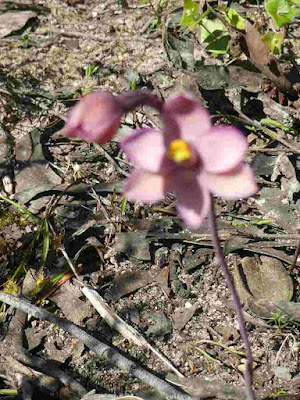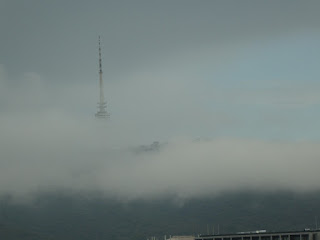Scaling the Piccaninny (Huge Post)
I thought I should offer a warning about the size of this post so that folk on limited download can choose whether to open it.
Frances thought that we could manage to ascend The Piccaninny as it was rated as Easy/Moderate. Mount Sturgeon was also a possibility but a fair bit longer and higher. Before tackling that we did our morning heartstarter walk extending it a bit to come back along Salt Creek. Fortunately Frances looked closely at the marked up map from the Visitor Centre and realised the track was on the South side of the Creek (after I had followed an illusory track towards the Northern side)!
We came across a sign about an art work and initially couldn't spot it. Then we did as well looked from the correct position. Rocks on wire (marked 1 and 2) suspend a wire canoe over the creek. The work is "Hide" by Trevor Flinn. It was sponsored by Maria and Allan Myers, owners of the walled garden.
"What is beyond along the path?" Allison Eggleton, sponsored by the Shire."Flower Power" Brian Kermond, sponsored by the Myers.
No title, by Dean Smith.
A local was curious about us.
This turns out to be an escapee Ixia sp.
The main business was to climb the Piccaninny. A slight frustration was that the Parks sign didn't indicate that the car park was 100m up (good word that) a dirt track. When we found others up there I trotted down and drove up. This meant the distance we walked on the track actually 1.9 km rather than the 2.1 shown: however its clear that the distance shown on the Parks sign is the straight line measure not the actual route.
We started to notice flowers as soon as we left the bitumen. In most cases the books we had enabled us to work out what plants were, and this has been confirmed by iNaturalist. In a few cases the Artificial Intelligence in that app proved that it is more Artificial than Intelligent giving suggestions of species endemic to Tasmania (sort of allowable) or the Galapagos (FFS).
A Lily, Chaemescilla corymbosa
Our first orchid, Caladenia carnea ( I think). Excuse the naff photograph.
A new (to us) donkey orchid, Diuris corymbosa.
An old friend D. pardina
Another naff photo: I was getting a tad frustrated with the limited range of species shown in our books in the field and didn't focus a) the camera or b) my mind. My thinking, based on colour, is Thelymitra rubra but the iNaturalist AI says T. carnea. You can't see the details such as calli on lobes of the column. A human from iNaturalist agrees with T. rubra so that is what it is.
I think this is Glossodia major but the colour and forward leaning dorsal sepal are strange.
Thelymitra ixioides
T. antennifera - Rabbit Ears showing the colour better than yesterday's examples.
Platylobium obtusangulum
Grevillea acquifolium
A plant! Neither iNaturalist nor I can put a name to this.
Caladenia tentaculata: I still spit chips at the ego-driven taxonomists not accepting the name Arachnorchis for this group of orchids.
I, and iNaturalist, think this is a Tetratheca sp but so far can do no better,
A very colourful form of Dillwynnia sericea.
I took this photograph for the orange and black jobbie and then noticed the small black one on the right side of the image. iNaturalist has been bold enough to list them as Insecta!
The tourist guide mentions the great views on the walk. They were good, but we spent most of pur time looking down at the plants. Here is looking North to Mount Abrupt.
This next is from the summit, looking more or less back at the town. The yellow is not canola but the Corella's favourite, Cape Weed
I think this is looking NW towards the Northern part of the range.Our first orchid, Caladenia carnea ( I think). Excuse the naff photograph.
A new (to us) donkey orchid, Diuris corymbosa.
An old friend D. pardina
Another naff photo: I was getting a tad frustrated with the limited range of species shown in our books in the field and didn't focus a) the camera or b) my mind. My thinking, based on colour, is Thelymitra rubra but the iNaturalist AI says T. carnea. You can't see the details such as calli on lobes of the column. A human from iNaturalist agrees with T. rubra so that is what it is.
I think this is Glossodia major but the colour and forward leaning dorsal sepal are strange.
Thelymitra ixioides
T. antennifera - Rabbit Ears showing the colour better than yesterday's examples.
Platylobium obtusangulum
Grevillea acquifolium
Isopogon ceratophyllus (Horny Cone bush)
Check the list of synonyms in that link! Stenanthera conostephioides seems to be the one currently in use after the taxonomists have done busywork to move it from Astroloma conostephioidesHakea rostrata
Thysanotus tuberosus (Fringe Lily)A plant! Neither iNaturalist nor I can put a name to this.
Caladenia tentaculata: I still spit chips at the ego-driven taxonomists not accepting the name Arachnorchis for this group of orchids.
I, and iNaturalist, think this is a Tetratheca sp but so far can do no better,
Definitely a Drosera (Sundew) but the taxonomists seem to have woven their magic on this and decreed it is now D. aberrans (until someone needs another published paper and changes it to something else)
A Callitris, possibly C. rhomboidea (so agreed by a human on iNaturalist).A very colourful form of Dillwynnia sericea.
Xanthorrhoea australis (as that is the only one shown in Flora of Victoria in the Grampians area).
Caladenia venusta see above comments about spider orchids: I am surprised the taxonomists haven't farnarkled about with the common names as they do with birds!I took this photograph for the orange and black jobbie and then noticed the small black one on the right side of the image. iNaturalist has been bold enough to list them as Insecta!
The tourist guide mentions the great views on the walk. They were good, but we spent most of pur time looking down at the plants. Here is looking North to Mount Abrupt.
This next is from the summit, looking more or less back at the town. The yellow is not canola but the Corella's favourite, Cape Weed
In a conversation in the village later I was reminded that much of the Grampians was trashed by a huge bush fire in 2006. A wind change sent it towards Moyston and Pomonal rather than Dunkeld





































Comments
Post a Comment